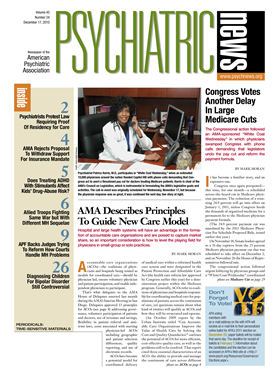Attention-deficit/hyperactivity disorder (ADHD) is associated with increased risk of illicit drug use. However, the slowly growing body of scientific literature on the topic shows mixed outcomes about the relationship between stimulant treatment and drug use, said Brooke Molina, Ph.D., an associate professor of psychiatry at the University of Pittsburgh, at the American Academy of Child and Adolescent Psychiatry (AACAP) annual meeting in New York in October.
“Some studies show protective effects of stimulants, some show predisposing effects, and some show no association at all,” said Molina. “This literature is still relatively new, and we cannot say if stimulant treatment protects against later drug abuse.”
These studies also have problems, including a large range of sample sizes, different age ranges at follow-up, and varying ways that treatment and outcomes were operationalized, she pointed out.
Molina began her career by studying children of alcoholics and noticed that their symptoms overlapped with those of children with ADHD. In addition, core symptoms of ADHD, such as inattention, impulsivity, hyperactivity, and restlessness, are also implicated in addiction.
“There are also similarities in brain areas implicated and in genetic vulnerabilities,” she said. “In ADHD, we need to think about both impairments and symptoms.”
At the AACAP meeting, Molina reported on eight-year outcomes of the association between ADHD treatment and substance use from the NIMH-sponsored Multimodal Treatment Study of Children With ADHD (MTA).
The MTA was a large, multisite, randomized treatment trial of 436 patients with a narrow age range (7 to 9.9 years at baseline).
The initial MTA trial randomly assigned patients to one of four treatment conditions: medication only, behavioral treatment only, combined medication and behavioral, or assessment and referral.
Molina studied risk for substance use among these children in the years after the formal end of treatment. Treatment didn't appear to have much effect on rates of substance use, which were fairly high in both the ADHD and control groups. At the two-year follow-up, the two groups receiving behavioral therapy showed slight protective effects, but that disappeared at three years, she said.
“By eight years, there was no visible harm, but no protective effect either,” said Molina. “Use of behavioral therapies was associated with reduced substance use or experimentation in early adolescence. We'll have more information at 12 years, but adolescent substance abuse appears to be episodic and socially mediated.”
Early ADHD symptom patterns were the most predictive, regardless of treatment type.
“ADHD increases risk for substance use disorders—especially tobacco and marijuana—in adolescents, but [use of] stimulants is not associated with any visible harm,” commented discussant Paula Riggs, M.D., a professor of psychiatry at the University of Colorado at Denver School of Medicine.
Psychiatrists need to be aware of other factors as well, said Riggs.
“The neurological literature is reporting that dopamine agonists in adults with Parkinson's disease are associated with new onset of pathological gambling and compulsive sexual behavior, but the psychiatric literature is not yet onto this,” she said.
There may also be social forces acting to affect teen drug use, said Riggs. The rise found in 2008 and 2009 in teenagers' illicit drug use may have been due to a reduction in perceived risk paralleling increased visibility of medical marijuana.
“Does ADHD itself increase the risk of conduct disorder, which is a leading risk factor for substance disorder?” she asked. Possibly, although diagnosis of persistent oppositional defiant disorder after treatment may also indicate that the youth are hanging out with bad peers.
On the same panel, Sylvie Mrug, Ph.D., of the University of Alabama-Birmingham, discussed data on peer rejection from the MTA study.
Mrug hypothesized that peer rejection may be one of the missing links that explains persistence of symptoms and impairment into adolescence and adulthood.
ADHD not only affects the individual diagnosed with the disorder but also his or her relationships with classmates and other peers, she suggested.
Peer rejection is much more common in children with ADHD. Mrug and colleagues' studies compared children in the MTA study with non-ADHD classmates by asking each member of one group to rate each member of the other.
Students with ADHD were ranked lower by their peers on several scales. About 53 percent of adolescents with ADHD were rejected by their peers, compared with 14 percent of their randomly selected classmates. Just 3 percent of the ADHD subjects were termed “popular,” compared with 23 percent of the non-ADHD students.
This rejection persists over time and is resistant to ADHD treatment, she said. “As with other children, rejection leads to antisocial behavior, depression, and anxiety, much like ADHD does.”
Children with ADHD often have fewer social and cognitive skills and fewer chances for positive interactions, cooperation, and conflict resolution. They produce more inept social responses but don't see themselves as inept. They are more likely to be victimized by peers.
Even at eight years into the study, it is still possible to see greater impairment in those who were rejected by peers at baseline.
Many children with ADHD are rejected by their peers but it's the rejection, rather than the ADHD itself that explains many of the negative outcomes in middle adolescence, said Mrug.
“Peer rejection is real, and it is prognostic of long-lasting outcomes,” she said. “It is very important to discern peer rejection early from interviews with parents and children.”
The Child Behavior Check List also has useful questions that can provide that information, she noted.
“With early intervention, children can be referred to social skills training, but that alone won't stop peer rejection,” said Mrug. They also need to be directed to activities or places (like field trips or clubs) where they can develop a sense of social belonging.
“We need to help these children compensate for peer rejection by helping them form friendships and prevent longer-term problems like smoking, anxiety, and peer victimization,” said Mrug.

